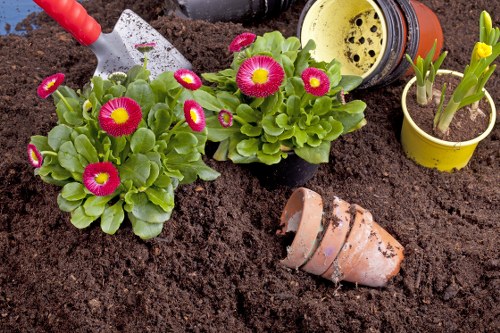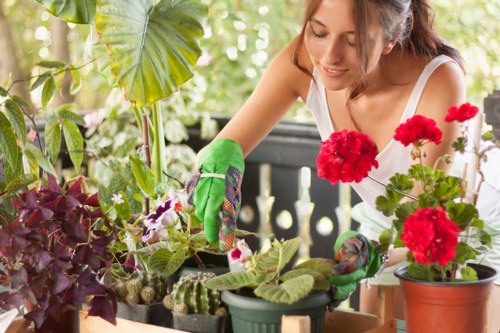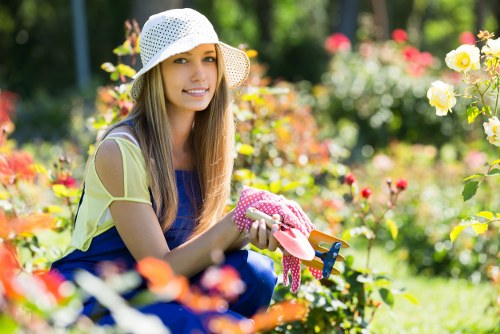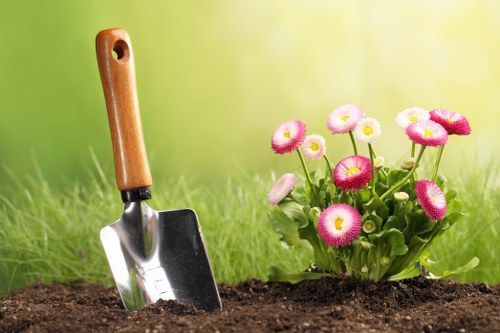Transform Your Outdoor Space: Landscape Gardening in Penge

Welcome to the ultimate guide on landscape gardening in Penge. Whether you're a seasoned gardener or just starting, Penge offers a unique environment to create stunning outdoor spaces. In this article, we'll explore various aspects of landscape gardening tailored specifically for Penge residents.
Penge, located in the heart of London, is known for its vibrant community and diverse architectural styles. This diversity presents both challenges and opportunities for landscape gardeners. Understanding the local climate, soil conditions, and community preferences is essential for creating a harmonious garden.
One of the first steps in landscape gardening is planning. Proper planning ensures that your garden not only looks beautiful but is also functional and sustainable. We'll delve into effective planning strategies that consider Penge's unique features.
Understanding Penge's Climate and Soil

Penge enjoys a temperate climate, which is conducive to a wide variety of plants. However, it's crucial to understand the specific microclimates within your garden. Factors such as sunlight exposure, wind patterns, and soil type can significantly impact plant health and growth.
The soil in Penge can vary, but generally, it's a mix of clay and loam. Conducting a soil test is advisable to determine pH levels and nutrient content. Based on the results, you can amend the soil to create the perfect environment for your chosen plants.
Good soil preparation is the foundation of any successful garden. Incorporating organic matter, such as compost, improves soil structure and fertility. Additionally, proper drainage is essential to prevent waterlogging, especially during Penge's occasional heavy rains.
Choosing the Right Plants for Your Garden

Selecting plants that thrive in Penge's climate ensures a vibrant and low-maintenance garden. Consider a mix of perennials, annuals, shrubs, and trees to add variety and year-round interest.
Some popular choices for Penge gardens include:
- Roses – Timeless and versatile, roses add color and fragrance.
- Lavender – Known for its scent and resistance to pests.
- Hostas – Ideal for shaded areas with their lush foliage.
- Japanese Maple – Provides stunning autumn color and structural interest.
Incorporating native plants is also beneficial as they are well-adapted to the local environment, requiring less water and maintenance.
Designing Your Garden Layout

A well-thought-out garden layout enhances both aesthetics and functionality. Start by sketching the layout, considering elements like pathways, seating areas, and focal points such as water features or sculptures.
Use the principles of design, including balance, contrast, and harmony, to create a visually appealing space. For instance, balance can be achieved by distributing plants and structures evenly, while contrast can be introduced through varying plant textures and colors.
Additionally, consider vertical gardening to maximize space, especially if your garden is on a smaller plot. Trellises, arbors, and vertical planters can add height and dimension.
Implementing Sustainable Practices

Sustainability is a key aspect of modern landscape gardening. Implementing eco-friendly practices not only benefits the environment but can also reduce maintenance costs.
- Rainwater Harvesting – Collecting rainwater for irrigation conserves water and reduces utility bills.
- Composting – Recycling garden and kitchen waste into compost enriches the soil.
- Native Plant Selection – As mentioned earlier, native plants require less water and are more resilient.
- Organic Pest Control – Using natural methods to manage pests minimizes chemical usage.
By adopting these practices, your garden will not only be beautiful but also environmentally responsible.
Enhancing Your Garden with Hardscaping

Hardscaping refers to the non-living elements of your garden, such as paths, walls, decks, and water features. Incorporating hardscaping can add structure and functionality to your outdoor space.
When selecting hardscape materials, consider durability and aesthetic appeal. Popular choices include natural stone, brick, and wood. These materials can complement the plants and overall design of your garden.
Pathways guide visitors through your garden and can be designed in various styles, from formal geometric patterns to more relaxed, winding paths. Proper lighting along pathways enhances safety and highlights garden features at night.
Lighting Your Landscape Garden

Outdoor lighting plays a crucial role in extending the usability of your garden into the evening hours. It also adds a magical ambiance and highlights key features.
There are several types of outdoor lighting to consider:
- Path Lights – Illuminate walkways for safety and ease of navigation.
- Spotlights – Highlight specific plants or architectural features.
- String Lights – Add a festive touch to seating areas or pergolas.
- Solar Lights – Eco-friendly options that harness solar energy.
When designing your lighting plan, ensure that it complements the garden's design without causing light pollution. Using timers and motion sensors can also enhance energy efficiency.
Creating Functional Spaces

Designing functional spaces within your garden enhances its usability and enjoyment. Areas such as dining spaces, lounges, and play areas cater to different activities and needs.
For example, a shaded seating area with comfortable furniture provides a perfect spot for relaxation, while an open lawn area is ideal for gatherings and outdoor games.
Incorporating features like pergolas, gazebos, or outdoor kitchens can elevate the functionality of your garden, making it an extension of your home.
Maintenance Tips for a Thriving Garden

Regular maintenance is essential to keep your landscape garden in Penge healthy and vibrant. Here are some essential tips:
- Watering – Ensure plants receive adequate water, especially during dry spells. Drip irrigation systems can help manage water efficiently.
- Pruning – Regularly prune plants to encourage growth and remove dead or diseased branches.
- Weeding – Keep weeds under control to prevent them from competing with your plants for nutrients.
- Mulching – Apply mulch to retain moisture, regulate soil temperature, and suppress weed growth.
- Fertilizing – Provide necessary nutrients to your plants through appropriate fertilization schedules.
Consistent maintenance ensures that your garden remains a beautiful and inviting space throughout the year.
Incorporating Water Features

Water features, such as ponds, fountains, or waterfalls, add a serene and calming element to your landscape garden. They can also attract wildlife, enhancing the ecological balance of your garden.
When planning a water feature, consider the size and location to ensure it complements the overall garden design. Maintenance is also a key consideration, as water features require regular cleaning and upkeep.
Solar-powered options are available for those seeking eco-friendly solutions. These features are not only sustainable but also add to the garden's aesthetic appeal without increasing energy costs.
Seasonal Planting Strategies

To maintain year-round interest in your garden, adopt seasonal planting strategies. Each season offers unique opportunities to showcase different plants and colors.
Spring: Plant bulbs like tulips and daffodils for vibrant blooms.
Summer: Focus on flowering annuals and perennials that thrive in the warmth.
Autumn: Incorporate plants with colorful foliage, such as mums and ornamental grasses.
Winter: Use evergreen plants and ornamental branches to add structure and interest.
Planning for each season ensures that your garden remains lively and attractive throughout the year.
Utilizing Garden Accessories

Garden accessories can enhance the beauty and functionality of your outdoor space. Items such as benches, sculptures, birdbaths, and decorative pots add personality and charm.
When selecting accessories, choose pieces that complement your garden's style. For example, a modern garden may feature sleek, minimalist pieces, while a cottage garden might incorporate rustic and whimsical items.
Additionally, consider the placement of accessories to create focal points and guide the flow of movement through your garden.
Integrating Technology in Landscape Gardening

Modern technology can greatly enhance your landscape gardening experience. Smart irrigation systems, automated lighting, and garden monitoring devices make maintenance easier and more efficient.
Smart irrigation systems adjust watering schedules based on weather conditions, ensuring optimal plant health while conserving water.
Automated lighting can be programmed to illuminate your garden at specific times, enhancing security and ambiance without manual intervention.
Hiring Professional Landscape Gardeners in Penge

While DIY gardening is rewarding, hiring professional landscape gardeners in Penge can take your garden to the next level. Professionals bring expertise, experience, and access to specialized tools and resources.
When selecting a landscape gardener, consider factors such as their portfolio, client reviews, and understanding of your vision and budget.
Collaborating with a professional ensures that your garden is not only aesthetically pleasing but also functional and sustainable.
Cost Considerations for Landscape Gardening

Investing in landscape gardening can vary significantly based on the scope and complexity of the project. It's essential to establish a budget early on and prioritize elements that matter most to you.
- Planning and Design: Professional design services can streamline the process and ensure a cohesive look.
- Plant Selection: Choosing the right plants impacts both cost and maintenance needs.
- Hardscaping: Materials and labor for paths, walls, and other structures can influence the overall budget.
- Maintenance: Ongoing maintenance costs should be factored into your long-term budget.
By carefully planning and allocating resources, you can create a beautiful garden without exceeding your financial limits.
Conclusion: Create Your Ideal Garden in Penge

Landscape gardening in Penge is an exciting journey of transforming outdoor spaces into personal sanctuaries. By understanding the local environment, selecting appropriate plants, and incorporating sustainable practices, you can create a garden that reflects your personality and enhances your property's value.
Whether you choose to undertake the project yourself or hire a professional, the key is thoughtful planning and consistent maintenance. Embrace the beauty and potential of your outdoor space, and enjoy the countless benefits that a well-designed garden in Penge has to offer.
Ready to transform your garden? Contact us today and let our expert landscape gardeners in Penge help you bring your vision to life!